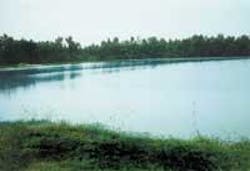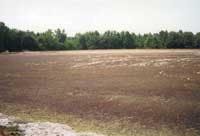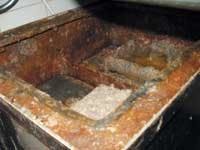Fat, oil and grease in pipelines and sewers cost billions in repairs
By Aziz Tejpar
Thousands of fat, oil and grease (FOG) related sewer spills every year cost billions of dollars for water authorities worldwide.
More than 100 tonnes of fat are poured down sinks every day in London, England, according to Thames Water, not just in restaurants and cafes, but in ordinary households. The water company says it clears more than 100,000 blockages from sewers on a yearly basis and believes that solidified fat caused more than half.
Speaking on a British Broadcasting Company (BBC) London radio programme in January 2002, Thames Water's Environment and Quality Manager Peter Spillett said, "Hot fat pours down sinks easily, but it quickly solidifies, causing blockages to sewer pipes. The smaller pipes close to customers' homes are most likely to be affected, risking blocked drains and flooding. This can quickly lead to pollution of rivers and streams if fat blocks the main sewer network."
Further evidence comes from the USA. "America's sewers are in a bad way. Three-quarters are so bunged up that they work at half capacity, causing 40,000 illegal spews a year into open water. Local governments already spend US$ 25 billion a year to keep the sewers running," according to Barry Newman, a reporter at the Wall Street Journal in an article published in June 2001. The Water Infrastructure Network (WIN) warns that it will cost an additional US$ 20 billion a year for the next 20 years to keep them from falling apart. WIN is a broad-based coalition of local elected officials, drinking water and wastewater service providers, state environmental and health administrators, engineers and environmentalists (http://win-water.org).
"Tree roots, corrosion, cave-ins, bottles, rusty car parts, almost anything will divert sewage on its way to the treatment plant. But the blockages now are almost all enveloped in fat and the main perpetrator is fried food," Newman added.
The major problem is that solids stick in fats and pipes slowly occlude. The fat hardens, chunks break off, flow down the pipe and jam in the machinery of underground pumps. That, to use a more digestible metaphor, can cause a municipal heart attack. There's also the problem of FOG coating and enveloping pumps in sewer lines, causing overheating and eventual burn out; replacement costs are expensive.
The cost of FOG related issues, above ground and in the sewer network, is hard to quantify, but a look at the effects demonstrates that substantial savings can be made from professional pipeline and drain line management.
On the commercial side, how much does it cost restaurants and fast food franchises in unbudgeted and emergency plumbing call out costs? Drains will be unblocked, albeit temporarily, before blockages reoccur and more money is spent to alleviate the problem. The only winner here is the plumber! Pipe work can be damaged with the overuse of caustic agents, chemicals and rodding, and pouring chemicals down the drain cannot benefit the environment.
Pipeline backups create environmental health problems. Raw sewage in food preparation areas is not a good idea and someone has to clean up the resultant mess. That person is either the staff or one from a specialist company; either way it's more expense and what of the damage to the reputation of the food purveyor?
For water companies the costs can be horrendous. Fifty thousand fat-related sewer blockages annually in the Thames Water region (nearly 1,000 a week) require a lot of manpower. Repairs to main sewers may be required as a result of serious blockages and the cost of repairing major items like pumping equipment that fails due to an ingress of fat can run into thousands of English pounds sterling.
So, is there a way to alleviate problems associated with FOG in drains and sewer networks? Scientists at Environmental Biotech Inc. of Sarasota, Florida, USA, developed the Grease Eradication System (GES) that uses bioremediation to eliminate waste grease and oil. Billions of live vegetative bacteria that feed on FOG are introduced into pipe work and drains and immediately begin consuming the waste, converting it into harmless carbon dioxide and water. Because they are live organisms, they can be introduced on site in the immediate vicinity of a problem where they begin to work instantly (Refer to sidebar).
Similar systems effectively treat other compounds such as starches, sugars, and gelatines, in addition to odour problems related to these compounds. During the research and breeding of the FOG-related bacteria, Environmental Biotech scientists discovered almost by accident, a bio enzyme that totally removes the smell of urine by eradicating the uric acid crystals that cause the odour.
This proactive service approach applies a management discipline to solving problems before they occur. It is much better to have no drain backup at all, rather than deal with it after it has happened, overflowed and caused major inconvenience.
For commercial operators in the food sector, a major tool in the long term maintenance programme is the installation of a system that injects live vegetative bacteria into pipes and drains twelve times each day. The reservoirs containing these short-lived bacteria are replaced every fourteen days. Bioremediation ensures that drain lines stay clear and flowing, helping to keep a facility up and running and on budget. By removing the FOG problem at source, the technology helps water authorities further down the line by reducing the occurrence of blockages in the sewer network.
The US Department of Agriculture (USDA) and UK Department of the Environment Food and Rural Affairs (DEFRA) approved the GES system, now being used in ten countries.
Author's noteAziz Tejpar is the director of Environmental Biotech UK, located in Chelmsford, England. For more information, contact the author at: Tel: 08702 406154 or (+44) 1245 500422)
Bioremediation prevents FOG mats threatening pump inlets
The East Side Pumping Station in Jersey City, New Jersey, USA, faced a serious problem with fat, oil and grease accumulations that formed a heavy, dehydrated blanket more than three metres thick. This gave rise to serious concerns that it would reach the pump inlets so a licensed waste removal company was hired to physically remove and dispose of the mass for more than US$ 230,000.
The pumping station transmits storm flow and wastewater to a major sewerage treatment plant in Passaic Valley. It has a peak flow of 227 million litres a day, and is situated 7.6 m below ground level with a wet well surface area of 214 m2 and a water depth of 3.35 m. The Passaic Valley Sewerage Authority in Newark owns the regional receiving plant, which discharges into Newark Bay.
Immediately after cleaning, the blanket began to reform and within two years was again approaching a critical state. At this point the city decided to investigate a more economical and sustainable means of handling the problem.
They contacted a firm of consulting engineers to undertake research to prevent FOG accumulations in the wet well. Their recommendations included removing the existing blanket; increasing the focus on controlling the sources of FOG; installing sub-surface biological mixers in the wet well; and injecting dense cultures of vegetative bacteria into the wet well.
The US sub-contractor Environmental Biotech of Sarasota, Florida, started the bacterial programme by first applying bacteria to the FOG blanket using a customised spraying system during the six-month trial period service.
Negligible accumulations of FOG appeared in the wet well at the end of this period. Prior to the control programme, the blanket had accumulated up to 91.4 cm in the same timeframe.
The bacterial injection programme was suspended at the end of the six-month trial period and any developed biomass was flushed from the system. FOG mats of up to 20.5 cm thick accumulated in the first month after suspension, despite an attempt to counteract the build-up by running the sub-surface mixers for longer periods each day.
Positive results from the six-month injection programme were vividly illustrated following the suspension of treatment and the return of the FOG mat. So successful was the treatment that Environmental Biotech has been awarded annual contracts to continue the service.




